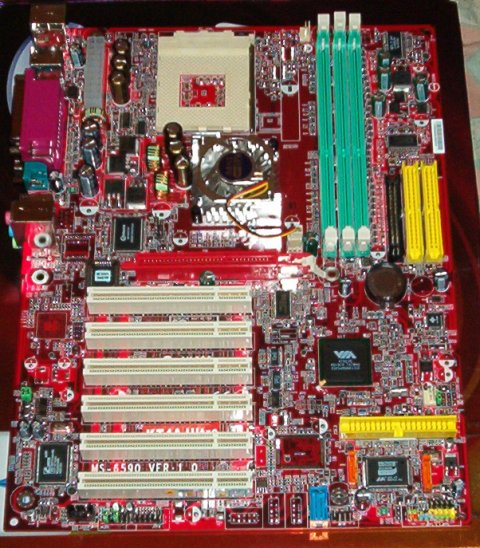|
Spec
| MSI KT4A Ultra | |
| |
Northbridge |
VIA VT8377A KT400A |
| Southbridge |
VIA VT8235CE |
| PCI |
6 x 32-bit, 33MHz |
| Audio |
C-Media CMI8378MX 6-channel |
| Ethernet |
None |
| IDE |
2 ports, 4 devices from VT8235CE, 1 port, 1 device from Promise PDC20376 |
| Memory |
3GB DDR400, 3 slots |
| USB2.0 |
4 backplate, 1 flyoff |
| Firewire |
None |
| Serial ATA |
2 channels from Promise PDC20376 |
| RAID |
RAID 0, 1 from Promise PDC20376 |
| Extras |
Bluetooth |
|
Quite a feature set from the MSI but no Ethernet. Why? Just put it on the boards for the love of god. Apart from that oversight, you get pretty much everything else. No FireWire (let's concentrate on what you don't get, just to be optimistic) but lots of USB2.0, Bluetooth (you sacrifice one of the 6 USB2.0 ports for that), Serial ATA which can be used in RAID mode via the popular Promise 20376 chip, good discrete audio from the C-Medio CMI8378MX and good expansion from 6 PCI slots.
I'm not going to get off my high horse about the Ethernet, given that many homes are 2 PC homes and benefit from networking, or that many broadband services are provisioned via an Ethernet hookup. It's as ubiquitous as on-board audio these days, sacrifice a serial port for it if you have to, nobody will miss it.
The Promise chip allows only a single hard drive to be connected to the PATA port (according to the manual and BIOS setup) but you can use the SATA ports at the same time.
A good feature set however, on to the layout.
|
Shot
Layout
MSI take the "we've got lots of coloured plastic ports and we can't just stick to a single colour scheme, we'd have too many spare colours left" route with the KT4A Ultra. A red PCB, green memory slots, white PCI, yellow IDE, black floppy, red AGP, silver northbridge heatsink, orange SATA, blue USB header. You get the idea. Picasso would have bought one at least.
Layout wise, let's have a closer look. The first thing we come across is the ATX power connector. It's a decent placement in some cases and it's a lot better than the location on many of the boards in this roundup. Decent amounts of power circuitry flank a north-south socket with no mounting holes.
We hit our regulation 3 memory slots next, followed by the VT8235CE provided IDE and floppy connectors. So far, so normal. Rounding off the top half of the board above the AGP slot we have a silver heatsink and clear fan arrangement. Not needed and a little noisy, I was half expecting an LED on the fan. If there was one, it wasn't working on the review sample.
Given it's a seven slot (6 PCI, AGP) design, the red AGP slot with retention mechanism (this should be a given on all motherboards, just like Ethernet) gets up close and personal with the upper half of the board. This means that the memory slots are too close to long AGP graphics cards for comfort, meaning its removal if you want to adjust your memory configuration.
The lower half of the board is a riot of sobriety as far as layout goes. Nothing shocking or out of place, just the little Promise chip surrounded on its east and west borders by the little SATA headers and on its north edge by the single PATA channel it provides.
Layout wise, it's fine. Nothing untoward or shocking. BIOS, bundle and manual time.
|










